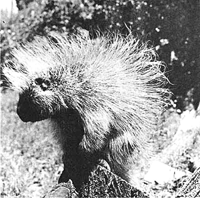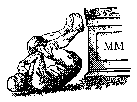How Do Porcupines Make Love?

A porcupine. Photo: U.S. National Park Service.
How do porcupines make love? You would probably think the answer is "very
carefully," but you would probably be wrong.
The answer is more improbable and much more bizarre than that. While browsing
in the basement of the Australian National University library one day, I
came across two papers (see references below) which described in great detail
the details of the porcupine’s sex life. The information contained
in these papers is of such great importance it is paraphrased and presented
here. The next time a friend asks you how porcupines make love, you can
set them straight by describing these events (in as much detail as you dare).
The Animals
The porcupines in the study were part of a colony kept at the Biology Department
at the University of Buffalo during the 1940s. The colony consisted of 5
females (Maudie, Nightie, Prickles, Snooks and Skeezix) and 3 males (Old
Dad, Pinkie,[1] and Johnnie).
Female pre-copulation
It was noted that the animals of both sexes objected to being stroked or
having their feet, tail base, or genitals touched by the authors. In July/August,
as the mating season approached, the female porcupine would often rub her
genitals on structures such as food and water dishes, sticks, and the cage
wire. As the season progressed she sought and accepted more frequent tactile
stimulation (presumably from the human investigators). As the mating season
approached, young females become more nervous and excited and put more "vim,
vigor and action" into their activities. They would even "seize,
straddle, and ride sticks about the cage" walking erect and stimulating
their genitalia with the stick. This period of excitement was followed by
a stage the female went off her food, remained close to the male and "moped."
During this period the female even accepted the insertion of a thermometer
into the vagina (which she resisted at other times).
Male courtship behaviour
When placed in a cage with a female the male porcupine toured the whole
area rubbing everything with his nose. He carefully smelled all items, paying
closest attention to objects that had been in contact with the female and
the places where she had urinated. He often walked about the cage on three
legs, clutching at his genitals with his free left front paw. Like the females,
the male rubbed his genitals on objects in the cage, and it appeared that
the larger the object the more attractive as a rubbing place. The authors
describe having to remove a one and a half inch spike from the frame of
one cage as they feared that the animal’s vigorous rubbing would result
in injury. Males also indulged in "stick riding" as described
for females. Males would often "sing"[2] during this period and
became more aggressive with other males. When the male encountered the female
porcupine he smelled her all over, then reared up on his hind legs, his
penis fully erect. If the female was not ready she ran away. If she was
prepared for mating she also reared up and faced the male, belly-to-belly.
In this position most males then sprayed the female with a strong stream
of urine,[3] soaking her from head to foot.[4] She would either 1) object
vocally, 2) strike with her front paws, as though boxing, 3) threaten or
try to bite, or 4) shake off the urine and run away. If ready for mating
the female did not object strongly to this shower. This courtship routine
occurred several times in the days or weeks leading up to copulation.
Mating
Mating occurred in November or December. While females at the peak of receptivity
would accept any male, males required a period of close association with
the females before they would mate with them. The male made sexual contact
from behind the female. The spines of both animals were relaxed and lay
flat. His thrusts were of the "usual nature" and were produced
by flexing and straightening the knees. Males did not grasp the female in
any way. Mating continued until the male was exhausted. Each time he broke
away from the female she would re-establish contact. One younger female
made grunting and whining sounds throughout. If males refused to co-operate,
the female approached a nearby male and acted out the male role in coition
with the uninvolved male. Females only remained sexually receptive for a
few hours and then rejected males.
Post-copulation
While the pre-copulatory period was described as "warming up,"
the post-copulatory period was a "cooling off" time. Females rejected
males, engaging in the same activities as for pre-copulation, but in reverse
order.
Conclusions
1. Young children should be banned from university library basements.
2. Sometimes the most improbable science is also the truest.
3. Never stand close to a cage that contains courting porcupines.
Notes
1. He was not pink at all, but albino.
2. Actually described as whining.
3. In one case, urine was measured on the lab floor 6 foot 7 inches from
the point of discharge.
4. Johnnie (a young and inexperienced male) would charge the female from
this position, trying to wrestle her to the ground and make sexual contact
ventrally. He was never successful.
References
"The Sex Reactions of Porcupines (Erethizon d. dorsatum) Before and
After Copulation," Albert R. Shadle, Marilyn Smelzer & Margery
Metz, Journal of Mammalogy, vol. 27, no. 2, 1946, pp. 116-21.
"Copulation in the Porcupine," Albert R. Shadle, Journal of Wildlife Management, vol. 10, no. 2, 1946, pp. 159-62.
© Copyright 2002 Annals of Improbable Research (AIR)
